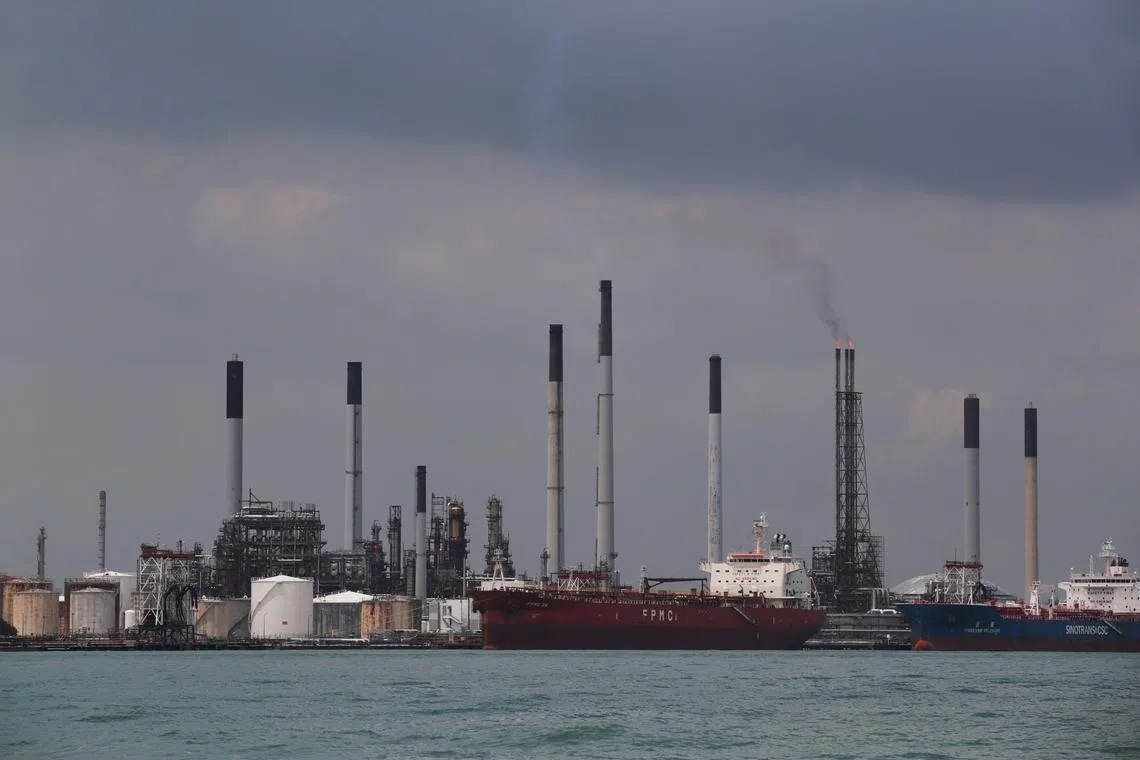S’pore looking into wider adoption of biofuels, bioresources to hit net-zero emissions target
Sign up now: Get ST's newsletters delivered to your inbox

More than 70,000 tonnes of biofuels have been supplied to ocean-going vessels as at end-2022.
PHOTO: ST FILE
Follow topic:
SINGAPORE - To reach net-zero carbon emissions by 2050,
The Ministry of Trade and Industry (MTI) and the National Climate Change Secretariat (NCCS) have called for a tender to examine potential sources of biofuels and natural renewables, such as food waste and animal fats, locally and internationally from up to eight countries, The Sunday Times has learnt.
This could help the Government secure more sources and types of biofuels for Singapore, accelerating the race towards net zero.
Singapore has already made some strides in this area: More than 70,000 tonnes of biofuels have been supplied to ocean-going vessels as at end-2022, and Singapore Airlines is using blended sustainable aviation fuel
Bioresources are raw materials from human or animal activity that are renewable and biodegradable, such as agricultural waste, food waste, palm oil waste and forestry waste.
Biofuels are fuels converted from biomass, such as biogas, biomethane and biodiesel. Biogas is produced when bacteria digest organic matter such as food waste and livestock waste.
Associate Professor Tong Yen Wah from the National University of Singapore’s (NUS) Department of Chemical and Biomolecular Engineering said that to get biomethane, the biogas has to be purified and upgraded by removing carbon dioxide and other minor components before it can be injected into piped networks to replace natural gas.
As part of the study, the Government is looking to establish technical standards for injecting biomethane into piped networks.
Dr David Broadstock, a senior research fellow at NUS’ Energy Studies Institute, said that using biomethane for energy generation can be quite important in the near term, given that Singapore relies largely on natural gas.
“Before new non-gas power generation gets implemented in Singapore, blending biomethane in larger quantities with natural gas will help lower the life-cycle emissions embedded in domestic power generation,” he said.
While this may vary depending on the type of biofuel, Professor Subodh Mhaisalkar, executive director designate for academic research at the National Research Foundation Singapore, said burning biofuels instead of fossil fuels can cut carbon emissions by around 60 per cent to 95 per cent.
From 2025, the Tuas Nexus Integrated Waste Management Facility will treat food waste and used water to produce biogas,
He added that horticultural biomass such as tree branches, leaves and grass cuttings have also been collected for use in energy production through combustion technologies at Gardens by the Bay and Jurong Island.
In response to queries from ST, MTI and NCCS said the study will consider the potential of various biofuels and sustainable bioresources, taking into account factors such as cost-effectiveness in emissions reduction and existing infrastructure for fuels and feedstocks. It should also explore suitable applications for deployment within Singapore up to 2050, they added.
In a tender uploaded on government portal GeBiz, the agencies are looking to hire a consultant who would have to provide, among other things, a projected timeline for these resources to be made ready for commercial use in Singapore.
The consultant will also have to consider price, life-cycle assessment and the country-level industrial policies of these resources, as well as take note of the average cost of electricity, when using these imported sustainable resources and biofuels.
In addition, the awardee of the tender will have to suggest end-use cases for these biofuels and bioresources. Some options include potential usage in heavy industries, such as for chemicals and plastics; transport, including land, water and air transport; as well as the power sector for large-scale electricity production.
The physical and socio-economic impact of the production and utilisation of selected biofuels and bioresources on biodiversity, land use and the carbon cycle would also need to be assessed.
Ms Cherine Fok, a partner in KPMG’s environmental, social and governance team, said biofuel production usually takes place on land that was previously used for agricultural crops.
However, increasing food demand could mean there would be competing uses for the same plot of land, causing forested areas to be used for agricultural production. The change in land use could therefore have a negative impact on the environment, causing more CO2 to be emitted in the atmosphere.
Mr Sanjeev Gupta, Ernst & Young’s Asia-Pacific oil and gas leader, said Singapore has “highly efficient” refinery capabilities for traditional fuels like oil, along with a robust maritime infrastructure for transportation.
Therefore, Singapore would have the capabilities to import these biofuels from countries and refine them for export, creating an opportunity to become a leader in biofuels processing as well as the trading landscape, if it could work out agreements with various parties, he added.
Mr Gupta noted that the United States, Canada, Brazil, Indonesia and India are leading countries in the biofuels and sustainable bioresources industry.
However, for Singapore to import biofuels, it would have to take into account shelf life, which is around four to six months if stored in a controlled environment.
Prof Tong said Singapore has an advantage because of its well-established chemical and refining industry, which could allow it to separate, purify and mass produce biofuels at a much lower cost.
“Relatively minor investments in research and development would quickly help us to transition from petrochemicals to biofuels and bioresources,” he added.
Dr Broadstock said turning towards biofuels could not only diversify the Republic’s energy mix, but also put in place “important building blocks” for a circular economy.
While Singapore’s size will not give it sufficient scale in terms of utilising and recovering bioresources, there is potential to work with countries in the region to operate at a scale that is cost-competitive.


